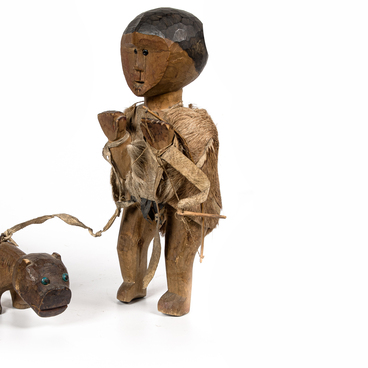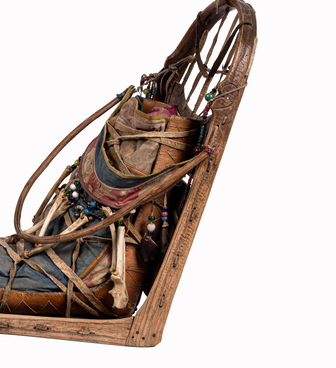The yangpan belt, worn over a robe and sometimes a skirt, was an important element of the shaman’s attire. The Nanai and Ulchi made it from elk or musk deer skin in the form of a strip which was from 12 to 18 centimeters wide. The belt girdled the waist at the back and sides, with narrow straps sewn to its ends, which were used to tie it at the front.
Metal pendants, rings, bells and chimes were attached in several rows to the shaman’s belt. To replace the lost pendants, any items of metal — parts of cars, bicycles, locks, guns were suspended to it.
The belt is made of fur strips twisted inwards and sewn together. On the edge there are deerskin straps with conical metal pendants and frog-shaped bells attached to it. The number of cone-shaped pendants could vary from 13 to 31. Most often they were forged by the shaman. Similar belts were common among the Ulchi, Nanai and Nivkh.
Sometimes metal zoomorphic figures were attached to the ends of rattle pendants on a small ring. They served as spirit-helpers. During the kamlanie — the ritual of communicating with the spirits — the shaman danced, rotating the lower part of their body and producing a clanking sound with each movement. It was necessary for the belt to be quite heavy in order to make a uniform background noise.
The shaman had to be physically sturdy, because the whole costume could weigh over 40 kilograms, with the metal pendants on the belt, costume, hat and other elements accounting for the bulk of it.
Traditionally, the shamanic belt was seen as an amulet. It was believed that its ritual ringing served as a signal to gather good spirits or awaken the spirits that were inside the metal cones. The ringing of the belt scared away evil spirits and made them move away.
The belt also served as a musical instrument. In addition to the sounds of the tambourine, it provided a proper accompaniment to the shaman’s dance. Besides, the belt was a symbol of the Middle (“earthly”) world. Some researchers have reason to believe that the shaman’s costume was a micro-model of the universe.
The belt was also
included in the attire of the Udege shamans. However, it had a different shape
and was made in the form of a snake (patron spirit) without metal pendants. The
functions of the belt were the same as those of the Nanai and Ulchi yangpan
belts.



